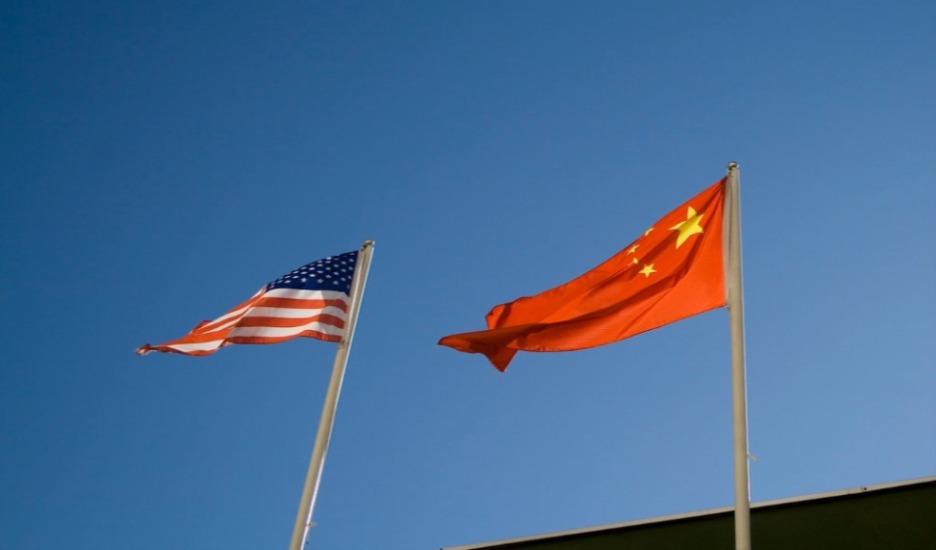Water Wars: Fighters, Flights, and Perhaps a FONOP
The Trump Administration Appears to Conduct its First Freedom of Navigation Exercises in the South China Sea Days After American and Chinese Aircraft Tangle Overheard
Published by The Lawfare Institute A Pair of Chinese SU-30 Fighter Jets (Photo: CNN) This week, the United States navy carried out what may be its first Freedom of Navigation Exercises (FONOPs) in the South China Sea since President Trump took office, just a few days after a close encounter between American and Chinese aircraft. On Wednesday, the destroyer U.S.S. Dewey sailed within twelve nautical miles of the disputed Mischief Reef in the Spratly Islands – that is, within the boundaries of a landmass’ “territorial sea,” under international law. Without confirming that the voyage was a Freedom of Navigation Operation, Pentagon Spokesperson Capt. Jeff Davis. Davis stated, “We operate in accordance international law…We fly, sail, and operate wherever international law allows.” Pentagon officials would not confirm on the record that the Dewey was conducting a FONOP, and said only that more details would be published in an annual FONOPs report. However, a Pentagon official said that the Dewey conducted a “man overboard” drill while close to Mischief Reef, an exercise of high seas freedoms indicating that the United States does not recognize Chinese sovereignty around Mischief Reef. If the Dewey was indeed conducting a FONOP, it would be the first that the Trump administration had carried out in the South China Sea. China condemned the maneuvers. Foreign Ministry Spokesperson Lu Kang said that “China is strongly dissatisfied and firmly opposed to this. China has indisputable sovereignty over the Nansha Islands and their adjacent waters.” Lu characterized the maneuvers as needless interloping in a situation that China and her neighbors were already managing successfully. He said, “With the concerted efforts of China and ASEAN countries, the situation in the South China Sea has gradually cooled down,” but the American maneuvers “severely disrupted the relevant dialogue and negotiation process, which serves no one’s interests.” He concluded by requesting that the American ships leave the area “so as to avoid any further damage to China-US cooperation and regional peace and stability.” Defense Ministry Spokesperson Ren Guoqiang made similar comments on Thursday. “The U.S. acts, aimed at showing off military power and pushing regional militarization, could have easily caused sea and air accidents,” he said, and warned that “Any wrong actions by the U.S. military will do nothing but spur the Chinese military to strengthen capabilities to safeguard national sovereignty and security.” Ren added that two Chinese guided-missile frigates, Liuzhou and Luzhou, “expelled” the Dewey from the area. Previously, some analysts speculated that the absence of FONOPs under the Trump Presidency represented a decision by Trump to reduce pressure on China in the South China Sea in order to gain Beijing’s cooperation in denuclearizing North Korea. While the resumption of FONOPs may allay some concerns about American abdication from the region, analysts disagree on how American allies will react. According to Andrew Shearer, a former Australian national security advisor, “It will be reassuring for America’s allies to see the resumption of freedom of navigation operations in the South China Sea.” However, according to Euan Graham of the Lowy Institute in Australia, “One operation won’t allay fears about Trump’s transactional approach toward China and its apparent disinterest in defending international and legal rights.” The FONOPs were not the only clash between the United States and China in the South China Sea this week. On Friday, a U.S. WC-135 Constant Phoenix radiation detection aircraft was intercepted by a pair of Chinese SU-30 fighter jets. U.S. Air Force spokeswoman Lieutenant Colonel Lori Hodge said the United States viewed the interception as “unprofessional,” based on reports by crew members. However, corresponding with reporters, Hodge declined to provide further details about the incident. She did say, however, that the WC-135 was operating on a routine mission in accordance with international law. Responding to Hodge’s characterization of the incident, the Chinese Ministry of Defense spokesperson Wu Qian stated that the interception was carried out to identify and verify the American aircraft, in a manner that “was professional and safe.” Wu stated that American aerial and naval reconnaissance activities in the South China Sea often lead to high-tension close encounters, and added that “We hope that the US side stops relevant reconnaissance activities, to avoid this kind of incident happening again.” The WC-135 is a “sniffer plane” that is designed to detect radioactive material released into the atmosphere following nuclear testing. The United States has been operating WC-135s in the area following a recent nuclear test by North Korea. Japan Japanese Prime Minister Shinzo Abe extended an olive branch to Chinese President Xi Jinping earlier this month. In a letter to Xi, Abe called for regular high-level visits and stronger ties between the two countries based on a mutually beneficial strategic relationship. The letter was delivered on May 15 by Toshihiro Nikai, the general-secretary of Japan’s ruling Liberal Democratic Party, who was visiting Beijing for the One Belt, One Road forum. Nikai also invited President Xi and other high-ranking officials to visit Japan. According to Japanese government sources, Chinese officials said they would consider the invitation, but did not commit to a visit by Xi. Neither President Xi nor Chinese President Premier Li Keqiang have visited Japan since taking their current positions in November 2012. One high-ranking Chinese official who will visit Japan is State Councilor Yang Jiechi. According to Kyodo News, Yang will visit next month to lay the groundwork for a meeting between Xi and Abe. The two leaders are expected to meet in July on the sidelines of the G20 meeting in Germany. One possible topic of discussion during Councilor’s Yang visit may be the Senkaku islands, as tensions rose once between China and Japan over the dispute islands, which China calls Diaoyu. The Japanese Coast Guard alleges that four Chinese Coast Guard vessels entered Japanese waters around Senkaku islands on May 18. While this was the thirteenth alleged intrusion into Japanese waters this year, Japanese officials claim that for the first time Chinese vessels were accompanied by a drone-like object. In response, Japan sent two F-15 fighter jets, an early warning aircraft and a surveillance plane to Senkaku. Japanese Defense Minister Tomomi Inada sharply criticized the use of a drone as “escalating the situation,” and called China’s actions “absolutely unacceptable.” After the incident, the Japanese Foreign Ministry lodged a complaint with the Chinese Embassy in Japan. China’s State Oceanic Administration confirmed in a statement on its website that four coastguard vessels had patrolled the Diaoyu islands; however, the statement did not acknowledge deploying a drone. The Japanese government also announced this week that it had discovered a document indicating that the members of the Ryūkyū royal family, which governed what is now Okinawa, landed on the Senkaku islands in 1819. According to Japan’s Office of Policy Planning and Coordination on Territory and Sovereignty, the finding rebuts China’s claim that Japan lacks historical ties to Senkaku. Meanwhile in Washington, President Trump’s nominee for US Ambassador to Japan, William Hagerty appeared before the Senate Foreign Relations Committee. During his confirmation hearing, Hagerty characterized the US-Japan alliance as “the cornerstone of regional peace and security,” and emphasized that the US commitment to the alliance is “ironclad.” Philippines In a speech last Friday , Philippine President Rodrigo Duterte said that Chinese President Xi Jinping threatened Duterte that China would “go to war” if the Philippines began to drill for oil in the South China Sea. By Monday, new Philippine Foreign Minister Alan Peter Cayetano walked back Duterte’s comments. In a televised briefing, Cayetano tried to dismiss the gravity of Duterte’s claim by suggesting that the word “war” can naturally come up in discussions about peace and conflict. He went on to explain that in his interpretation of a recent meeting between Duterte and Xi, there was no “bullying or pushing around” by China. When asked about Duterte’s comments during a press conference Chinese Foreign Ministry Spokesperson Hua Chunying directed reporters to Cayetano’s remarks. Hua further explained that China was “committed to solving the relevant disputes on the South China Sea through negotiation and consultation.” Duterte was criticized this week by Senior Associate Justice of the Philippine Supreme Court Antonio Carpio. In a speech on Thursday, Justice Carpio accused Duterte of providing a “green light” to Chinese island reclamation activities by not mentioning territorial disputes in the closing statement of last month’s ASEAN Summit. Justice Carpio also suggested that the Duterte administration focus on strengthening ties with the US. In particular, he recommended the Philippine government focus on convincing US counterparts to include Scarborough Shoal within the Mutual Defense Treaty, arguing that this was the only way China would stop its island reclamation efforts. Presidential Spokesperson Ernesto Abella pushed back on Carpio’s criticism and rejected the idea that Duterte should be blamed for Chinese reclamation within the South China Sea. Abella pointed out that Duterte inherited the problem of Chinese reclamation and militarization of the South China Sea that had been “ongoing for some years now.” Under Duterte, according to Abella, the Philippines and China enjoy warmer relations, notwithstanding disagreements in the South China Sea. China China has deployed two HQ-9 surface-to-air missiles on Hainan Island, according to a report by Israeli satellite imaging company ImageSat International. Hainan is a large island north of the Parcel Islands that is generally known as a vacation destination. The missiles were accompanied by some launchpads and a radar center. According to the ImageSat International report, the new missiles, along with already-existing Chinese HQ-9 missiles on Woody Island in the Paracel Islands, “creates a significant no-fly zone area above the largest maritime trade route in the area.” This development comes fast on the heels of last week’s report that China had installed rocket launchers on Fiery Cross Reef, at the other end of the South China Sea. During a tour or naval headquarters on Wednesday, President Xi Jinping said that the Chinese navy should “aim for the top ranks in the world,” according to a Defense Ministry statement. “Building a strong and modern navy is an important mark of a top ranking global military,” he was reported to say. Analysts this week reacted to the American maneuvers near Mischief Reef. Writing for Lawfare, James Kraska argues that “Mischief Reef is not entitled to a territorial sea for several reasons.” First, it is not under any state’s sovereignty. Though China has built a port and airfield on it, it is a mid-ocean low-tide elevation that cannot be appropriated. It is also located on the Philippine Continental Shelf. Second, since China has not established its sovereignty through litigation, arbitration, or any other lawful means, even if Mischief Reef was a natural island, it would lack a territorial sea. A territorial sea only attaches to features whose sovereignty is lawfully established. Third, China has not established baselines around Mischief Reef as required by Article Three of UNCLOS. As a result of all this, Kraska says, Mischief Reef lacks not only a territorial sea, but also national airspace. Also writing for Lawfare, Julian Ku explains that the Pentagon’s decision to conduct what appears to be a FONOP without confirming it as such is misguided. “The current mixed-messaging approach doesn’t seem to make China less angry, and it only muddles the clarity of the legal/political/diplomatic message the U.S. is trying to send,” he writes, and recommends that the Pentagon either fully describe the FONOPs “on the record,” or else reveal nothing about them at all. Ankit Panda, writing for The Diplomat, points out that Mischief Reef is unique in that it is not within twelve miles of any features that could themselves be entitled to territorial seas. Accordingly, given the sparse details released by the Pentagon, it is not clear whether the American operations were a FONOP, encroaching on what China views as its territory, or rather an innocent passage. Other analysts considered the South China Sea Code of Conduct that is currently being developed between China and the ASEAN countries. In an interview with the German broadcaster Deutsche Welle, Chatham House’s Bill Hayton argues that the document will likely never be signed. He says that China is currently engaged in a “charm offensive” with the ASEAN countries while it builds its military capacity in the Paracel Islands and elsewhere in the South China Sea. China is engaging in the process of developing a Code of Conduct as part of its current diplomatic push. However, Hayton argues that China “hates the idea of being legally bound by an agreement,” and so will not likely sign a binding Code. Moreover, China’s goals of building on Scarborough Shoal and limiting the applicability of any Code to the Spratly and Paracel Islands are likely unacceptable to many ASEAN countries, presenting a further obstacle to a deal. According to Ngo Minh Tri, managing editor of the Vietnamese newspaper Thanh Nien, China’s deployment of surface-to-air missiles, coupled with increased air patrols and naval activity, represent an increasingly-comprehensive system of monitoring and enforcing the air defense identification zone over the East China Sea that Beijing announced in 2013. Water Wars is our weekly roundup of the latest news, analysis, and opinions related to ongoing tensions in the South and East China Seas. Please email Sarah Grant with breaking news, relevant documents, or corrections.
in Cooperation With

The Trump Administration Appears to Conduct its First Freedom of Navigation Exercises in the South China Sea Days After American and Chinese Aircraft Tangle Overheard
In Other News…
Analysis, Commentary, and Additional Information
More Articles
-

How to Tell a National Security Story
A review of two books from Peter Roady and Andrew Preston. -

Students, Spies, and Self-Inflicted Wounds
The short-sightedness of limiting foreign students in the name of national security. -

Lawfare Daily: The Duty to Disobey Unlawful Orders
What is the duty to disobey unlawful orders?



.jpg?sfvrsn=5a43131e_9)


